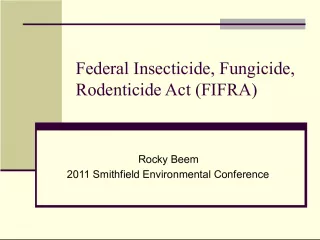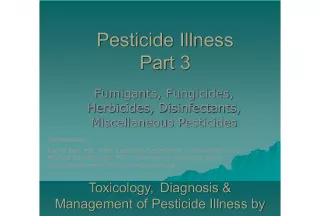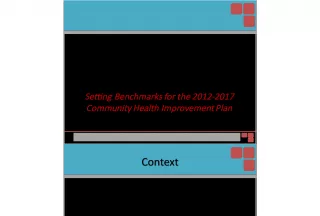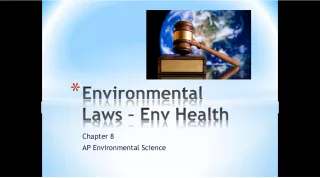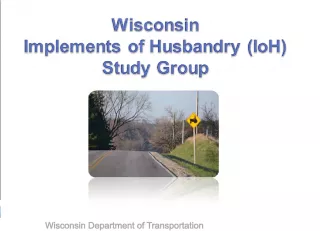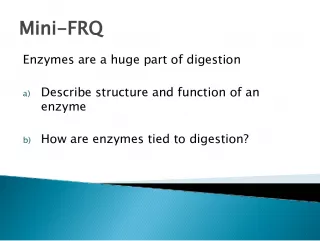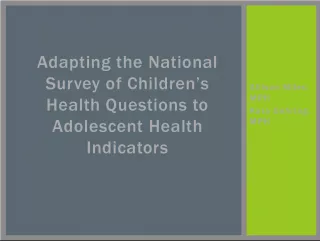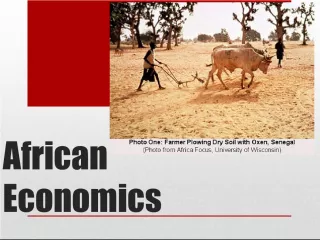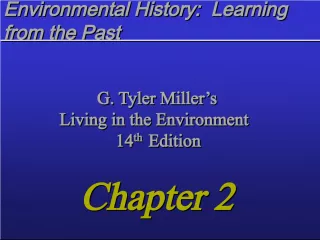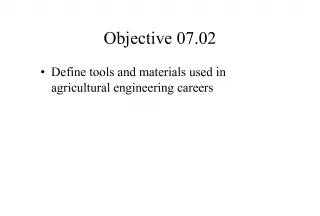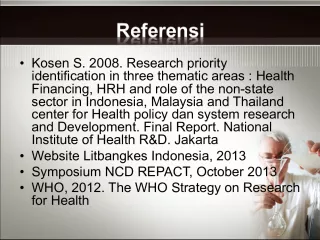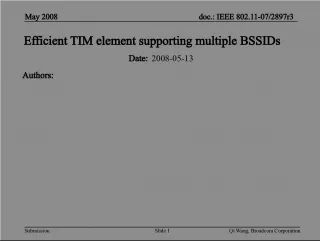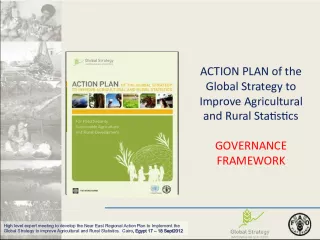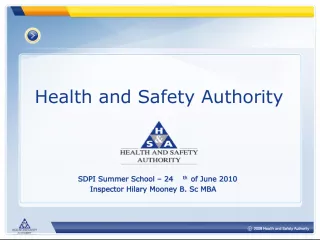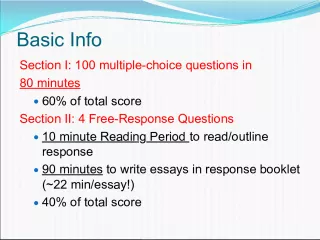Agricultural Health Study: Link between Pesticides and Multiple Myeloma


This article discusses the Agricultural Health Study, which provides preliminary evidence of a link between pesticides and multiple myeloma, a type of cancer. The study was conducted by the National Cancer Institute, the National Institute of Environmental Health Science, the U.S. Environmental Protection Agency, and the National Institute for Occupational Safety and Health. The article also covers the background, purpose, and scope of the study, as well as the epidemiologic design and exposure assessment. Additionally, it explores monoclonal gammopathy of undetermined significance (MGUS) and its presence in the study.
- Uploaded on | 0 Views
-
 isaiaswill
isaiaswill
About Agricultural Health Study: Link between Pesticides and Multiple Myeloma
PowerPoint presentation about 'Agricultural Health Study: Link between Pesticides and Multiple Myeloma'. This presentation describes the topic on This article discusses the Agricultural Health Study, which provides preliminary evidence of a link between pesticides and multiple myeloma, a type of cancer. The study was conducted by the National Cancer Institute, the National Institute of Environmental Health Science, the U.S. Environmental Protection Agency, and the National Institute for Occupational Safety and Health. The article also covers the background, purpose, and scope of the study, as well as the epidemiologic design and exposure assessment. Additionally, it explores monoclonal gammopathy of undetermined significance (MGUS) and its presence in the study.. The key topics included in this slideshow are Agricultural Health Study, pesticides, multiple myeloma, monoclonal gammopathy of undetermined significance, exposure assessment,. Download this presentation absolutely free.
Presentation Transcript
1. Agricultura l Health Study An Excess Risk of Multiple Myeloma (MM) and a Premalignant MM Disorder in the Agricultural Health Study Cohort Provides Preliminary Evidence of a Link to Pesticides
2. National Cancer Institute National Institute of Environmental Health Science U.S. Environmental Protection Agency National Institute for Occupational Safety and Health
3. 1) Why study Multiple Myeloma and why talk about it here? 2) Background: Purpose & Scope of the AHS. 3) Background: Epidemiologic Design of the AHS. 4) Background: Exposure Assessment in the AHS. 5) Multiple Myeloma and Farming 6) Monoclonal Gammopathy of Undetermined Significance (MGUS) 7) MGUS in the AHS 8) Biomarkers of Exposure & Effects of Agriculture (BEEA) Study
4. Multiple Myeloma is a malignancy of the plasma cell. The cause (etiology) of multiple myeloma is uncertain but farmers and farming have been associated with this malignancy in many studies conducted in North America, Europe and New Zealand. Five year survival is only 28% (i.e., 72% die within 5 years).
6. World-wide occupational exposure to pesticides exceeds 1 billion. Previous health studies characterized as having inadequate exposure assessment. Exposure misclassification can result from inadequate exposure assessment. Exposure misclassification reduces our ability to identify agents responsible for disease ( Zahm et al., 1997, Kromhout and Heedrick 2005). Case-control studies. Exposure information collected after disease onset- case-recall bias possible.
7. The International Agency for Research on Cancer (IARC) classifies only 1 pesticide (arsenical insecticides) and one pesticide contaminant (dioxin) as human carcinogens. [1991, IARC monograph volume 53]. Over 800 active ingredients in thousands of pesticide formulations are on the market world-wide. Some of these widely used pesticides are suspected to be human carcinogens, but a final determination has not been made because of limited evidence.
8. o To study a wide range of health effects of agricultural exposures in farmers and their families and commercial pesticide applicators. o Generate research generalizable to a much wider population world-wide.
9. o Major Exposures under study: o Pesticides o Animals o Engine exhaust o Solvents o Organic and inorganic dust o Health Effects under study: o Cancer o Respiratory Health o Reproductive Health o Neurologic Disease o Work Place Injuries
10. Family Exposure Opportunities
11. o Characteristics: o No extrapolation of results from lab animal to human. o No extrapolation from high exposures in animal testing to lower exposure in the human experience. o Results generalizable for the chemical evaluated in adults (within the range of exposures of the study). o Comprehensive exposure assessment to minimize misclassificationaccurately rank order exposures. o Prospective study to minimize information bias. o Control for confounders to obtain valid risk estimates. o Generate biological results to assess biological plausibility and modes of action and identify susceptible sub-populations.
13. Prospective design (exposure assessed prior to cancer onset) 52,000 private applicators (i.e., farmers and nursery operators) 32,000 spouses of farmers >4,000 commercial applicators (i.e., pesticide application for hire) Two important agricultural states (Iowa & North Carolina) Corn , soybean and hog production in both states Distinctive agriculture in North Carolina: fruits, vegetables, tobacco, cotton
14. Target population--licensed pesticide applicators (private & commercial applicators) : Knowledgeable about their chemical use, Regularly exposed but not exposed every day, Farmers tend not to move residence (easier to follow-up).
15. Comprehensive exposure assessment Initial questionnaires self administered (1993- 1997) Enrollment questionnaire administered at pesticide licensing examination/class82% participation of target population. Repeated questionnaires- Telephone interviews (1999-2003 & 2005-2010)-updated exposure & other information Field measurements of pesticides (sample of study subjects) EPA [n=69 2,4-D & n=17 chlorpyrifos on field crops] NIOSH [n=74 captan users in orchards].
16. Questionnaire content Lifetime pesticide use for >50 pesticides (days/year; years) Exposure determinants(e.g., pesticide application methods, equipment repair, mixed and/or applied, PPE) Other Farm activities and non-farm occupational exposures Lifestyle factors (e.g., smoking, diet, alcohol consumption) Medical history Family cancer history
17. Little loss to cancer incidence follow-up (<2 per cent) Population-based cancer registries in both states Monitor date study subjects move from state National Death Index (NDI) Over one-million person-years of follow-up in the AHS Buccal cells collected as a source of DNA 35,000 study subjects, 1999 through present
19. Concurrent pesticide exposures (e.g., information about >50 other pesticides and total pesticide use) Pesticide exposures and other occupational exposures (e.g., Non-farming occupational history, farm exposures other than pesticide use). Life-style (e.g., tobacco use, alcohol, diet, physical activity)
20. Biological Initial Reevaluation Evidence in Findings later in time Humans Iowa North Carolina License Type Exposure- Response Exposure- Response Exposure- Response Exposure- Response Exposure- Response Exposure- Response YES YES YES
22. Duration of use (yrs of use of >50 pesticides). Frequency of use (days per year of use >50 pesticides) . Intensity weighting factors Application method Mix Repair pesticide application equipment Personal protective equipment Reliability (repeatability) and Duration Validity . Comparison of questionnaire data to field measurements of pesticides
23. Cumulative Exposure = Duration X Intensity
24. Farmers in the AHS provide reproducible reports of pesticide use information (Blair et al, 2002) Specific chemicals and application methods Agreement 80-95% for ever vs. never use questionnaire data collected1 year apart Accurate information on duration of use (Hoppin et al., 2002) Compared to pesticide registration data Most applicators provided complete information on lifetime use of pesticides
25. Reliability of Pesticide Reporting in AHS Questionnaires (n=2,921 Iowa farmers one year apart). Factor (ever used) % Exact Agreement Kappa atrazine 86 0.62 glyphosate 82 0.52 2,4-D 87 0.71 terbufos 83 0.66 fonofos 84 0.63 chlorpyrifos 81 0.61 permethrin 88 0.59 From: Blair et al., Epidemiology; 13; 94-99
26. Intensity level=(Mix + Application Method + Repair)* PPE Information from questionnaires administered to all applicators. Information from monitoring studies from the published literature and the Pesticide Handlers Exposure Data Base (PHED EPA data base). Assessment of algorithm made with field measurements of pesticides. Assessment of algorithm made by comparing results to Canadian exposure assessment study.
27. GM ug/L Algorithm Exposure Score (mean score: 5.5, 9.4, 15.2 ) (n=69, 2,4-D applicators in the Agricultural Health Study ) Thomas K. et al. (2009) J of Exposure Science and Environmental Epidemiology 1-11.
28. GM (Ug/L in urine) Algorithm Exposure Score (1-<5, 5-10, >10-15) (n=39, 2,4-D applicators Pesticide Exposure Assessment Study) Coble J. et al. (2005) J of Occupational and Environmental Hygiene. 2: 194-201.
29. GM ug/L in urine Algorithm Exposure Score (1-<5, 5-10, >10-15) (n=42, MCPA applicators Pesticide Exposure Assessment Study) Coble J. et al. (2005) J of Occupational and Environmental Hygiene.2: 194-201.
30. AHS exposure algorithm scores consistent with pesticide exposure measurements (Thomas et al & Coble et al) Algorithm for the AHS were more closely related to measured urinary levels than any individual exposure determinant (e.g., acres, lbs active ingredient), consequently the algorithm should reduce misclassification (Blair A et al and Thomas et al.). Continued refinement of algorithm weights will be necessary as more exposure data is collected (Hines et al. & Thomas et al.) __________________________________ Thomas K. et al. (2009) J of Exposure Science and Environmental Epidemiology e-pub . Coble J. et al, (2005) J Occup and Environ Hyg 2: 194-201. Blair A et al., submitted Hines CJ. et al., (2008) Ann Occup Hyg 52(3):153-166.
31. Dose-response (exposure-response) Total life-times days of exposure to specific pesticide Intensity-weighted lifetime days. Verify exposures (i.e., compare questionnaire to field measures of pesticides) Temporal concordance Prospective exposure assessment Biological plausibility Biomarker studies of exposure and effect (toxicity pathways) Genetic susceptibility (GXE) Coherence and consistency Iowa vs. North Carolina Private vs. Commercial
32. Multiple Myeloma, MGUS and Pesticides in the Agricultural Health Study Cohort Multiple Myeloma, MGUS and Pesticides in the Agricultural Health Study Cohort Ola Landgren 1,2 , Robert Kyle 3, , Jane A. Hoppin 4 , Laura E. Beane Freeman 1 , Gabriella Andreottti 1 , Jon Hofmann 1 , Neil Caporaso 1 , Sharon Savage 1 , James R. Cerhan 3 , Jerry A. Katzmann 3 , S. Vincent Rajkumar 3 , Michael C. Alavanja 1 1 Division of Cancer Epidemiology and Genetics, NCI, Bethesda, MD; 2 Medical Oncology Branch, NCI, Bethesda, MD; 3 College of Medicine, Mayo Clinic , Rochester, MN; 4 Epidemiology Branch, NIEHS, NIH, Research Triangle Park, NC.
33. Relative risk= incidence of disease in the exposed population/ incidence of disease in the unexposed population. [null RR=1] Odds ratio is a good approximation for rare diseases
34. Multiple Myeloma: Background Multiple Myeloma is a malignancy of plasma cells (differentiated B cells). Characterized by the presents of elevated number of plasma cells in the bone marrow. Very often, also characterized by monoclonal proteins in serum and urine (IgA, IgD, IgE, IgG or light chains). Five year survival is only 28%.
35. Multiple Myeloma: Background The cause (etiology) of multiple myeloma is uncertain but farmers and farming have been associated with this malignancy in many studies conducted in North America, Europe and New Zealand. Other associations: age, obesity, personal use of permanent hair dyes (>20 years), certain medications, autoimmune disorders, male gender, African-American greater than European-Americans greater than Asians- Americans, some other factors suspected.
36. MGUS ----> Multiple Myeloma (MM) MGUS=Monoclonal gammopathy of undetermined significance MM always preceded by a premalignant disorder MGUS (Landgren O, et al., Blood 2009;113:5412- 5417 )
37. Multiple Myeloma: Background Over 1 billion people are occupationally exposed to pesticides world-wide. SIR of multiple myeloma in Agricultural Health Study (AHS) = 1.34 (0.97-1.98).
38. Human Carcinogen Epidemiology Biological Plausibility Exposure Assessment
39. Methods The prevalence of MGUS in a sample (n=555) of men > 50 years from the AHS cohort was compared to the prevalence of MGUS in a population-based sample (n=9,469) of men from Olmsted County, MN > 50 years.
40. Table 1. MGUS prevalence (%) among 678 men in the Agricultural Health Study and 9,469 men in Olmsted, MN
41. Age Agricultural Health Study Olmsted County, MN MGUS, n/ Total , n Prevalence (95% CI) MGUS, n / Total, n Prevalence (95% CI) <50 0/ 123 0 0/ 0 NA 50-59 5/ 214 2.3 (1.0-5.4) 82/ 4038 2.0 (1.6-2.5) 60-69 10/ 182 5.5 (3.0-9.9) 105/ 2864 3.7 (3.0-4.4) 70-79 18/ 129 14.0 (9.0-21.1) 104/ 1858 5.6 (4.6-6.7) > 80 5/ 30 16.7(7.1=34.3) 59/ 709 8.3 (6.5-10.6) Total > 50 years 38/ 555 6.8 (5.0-9.3) 350/ 9468 3.7 (3.3-4.1) Logistic regression adjusted for age yields an odds ratio=1.9 (95% CI, 1.3-2.7)-------------p for trend<0.001
42. Table 2. Specific pesticide use at enrollment and the risk of MGUS
43. Pesticide Exposed Total, n MGUS, n Odds ratio (95% CI) Dieldrin Never 649 31 1.0 (reference) Ever 20 6 5.6 (1.9-16.6) 2,4-D Never 139 5 1.0 (reference) Ever 537 33 1.8 (0.7-3.1) Carbon-tetra- chloride/carbon- disulfide mix Never 632 31 1.0 (reference) Ever 41 7 3.9 (1.5-10.0) Chlorothalonil Never 561 28 1.0 (reference) Ever 115 10 2.4 (1.1-5.3) Diazinon Never 435 19 1.0 (reference) Ever 242 19 1.8 (0.9-3.6)
44. 1) Multiple Myeloma in excess in AHS SIR=1.34 (0.97-1.81 ) ( 1) Multiple Myeloma in excess in AHS SIR=1.34 (0.97-1.81 ) ( Alavanja MCR, et al. Scand J Work Environ Health 2005:31 suppl 1:39- 45). 2) Monoclonal gammopathy of undetermined significance (MGUS) 2-fold significant excess in AHS (Landgren O. et al., Blood (2009), 113(25);6386-6391). 2) Monoclonal gammopathy of undetermined significance (MGUS) 2-fold significant excess in AHS (Landgren O. et al., Blood (2009), 113(25);6386-6391). 3) Several widely used pesticides are associated with elevated MGUS levels (Landgren O. et al., Blood (2009), 113(25);6386-6391). 3) Several widely used pesticides are associated with elevated MGUS levels (Landgren O. et al., Blood (2009), 113(25);6386-6391). 4) Odds ration for multiple myeloma = 5.7 (2.1-7.2) for heaviest users of permethrin (Rusiecki J, et al., Environ. Health Perspectives (2009), 117;581-586). 4) Odds ration for multiple myeloma = 5.7 (2.1-7.2) for heaviest users of permethrin (Rusiecki J, et al., Environ. Health Perspectives (2009), 117;581-586).
45. SIGNIFICANCE Several million Americans use pesticides for which we found an association with MGUS in the AHS. Causes of MGUS risk might be an underlying explanation of the previously observed excess of multiple myeloma risk among persons exposed to pesticides, including those in the AHS .
46. STRENGTHS Comprehensive pesticide exposure assessment for AHS cohort. Minimal misclassification of MGUS since both the AHS cohort and Olmsted County samples analyzed by the Mayo Clinic Laboratory. Any minimal misclassification of pesticide use would be non-differential
47. LIMITATIONS Unable to evaluate certain pesticides due to limited number of exposed cases. Results generalizable mostly to white males.
48. Future Research To further explore the associations between pesticides and MGUS and multiple myeloma, a follow-up study of 1,600 AHS study subjects was initiated in June 2010 (approx. 3X size of the previous study). Will examine additional pesticides with additional exposure assessment from 1998- 2009. Will examine other biomarkers of relevance to pesticide exposure and/or multiple myeloma
49. >110 peer reviewed manuscripts have been published from the Agricultural Health Study they are listed at: papers have been published from the Agricultural Health Study , the complete current bibliography can be found at > http://aghealth.nci.nih.gov/publications.html . Under the major topic headings: 1. 1. Methods 2. 2. Exposure Assessment 3. 3. Health Outcomes 4. 4. Diet 5. 5. Injury Under the major topic headings
50. National Cancer Institute: Michael Alavanja Laura Beane Freeman Jay Lubin Stella Koutros Gabriella Andreotti Jonathan Hofmann Neil Caporaso Ola Lundgren Sharon Savage Rashmi Sinha Aaron Blair Shelia Zahm Kathryn Hughes NIOSH Cynthia Hines Brian Curwin Paul Henneberger Greg Kullman NIEHS Jane Hoppin Dale Sandler Freya Kamel Donna Baird Olga Basso Stephanie London Beth Regan David Umbach Clarice Weinberg Martha Montgomery Sharon Myers Tina Saldana Martin Valcin Jenna Waggoner USEPA Kent Thomas Carol Christensen
51. Please support our research effort , we are making tremendous progress. Thank you for your excellent work in promoting the health of farmers and their families.
53. Dosemeci M, et al. (2002) Ann Occup Hyg. Vol 46 (2), 245-260. Factor Score Mix No=0 Yes=9 Apply Banded=2 Broadcast spray=3 Hand spray=9 Repair No=0 Yes=2 PPE See next table
54. Dosemeci M, et al. (2002) Ann Occup Hyg. Vol 46 (2), 245-260. PPE Categories Overall PPE Score PPE-3 PPE-2 PPE-1 PPE-0 Yes Yes Yes No 0.1 Yes Yes No No 0.3 Yes No Yes No 0.4 No Yes Yes No 0.5 Yes No No No 0.6 No Yes No No 0.7 No No Yes No 0.8 No No No Yes 1.0 PPE-3=chem. resistant gloves; PPE-2=cartridge respirator or gas mask, disposable outer clothing; PPE-1=face shields or goggles, fabric/leather gloves, other PPE such as boots; PPE-0=no PPE
55. Intensity Score= (Mix + Application Method + Repair) * PPE 1. Mixed (yes) = 9 2. Application method (Hand spray)= 9 3. Repair (yes) = 2 4. PPE (chem. resistant gloves & boots) = 0.4 Intensity Score=(9+8+2)* 0.4 = 7.6 Dosemeci M, et al. (2002) Ann Occup Hyg. Vol 46 (2), 245-260.
56. Cumulative Exposure = Duration (days) X Intensity (mgs*/day)
57. Comprehensive exposure assessment Initial questionnaires self administered (1993-1997) Enrollment questionnaire administered at pesticide licensing examination/class82% participation of target population. Take-home questionnaire (applicators), Spouse enrollment questionnaire Repeated questionnaires- Telephone interviews (1999- 2003 & 2005-2010)-updated exposure & other information Field measurements of pesticides (sample of study subjects) EPA [n=69 2,4-D & n=17 chlorpyrifos on field crops] NIOSH [n=74 captan users in orchards].
58. 1. Life time Exposure Days (specific pesticide) = Yrs Application (specific pesticide) * Days of application/Yr (specific pesticide) 2. Intensity Weighted Lifetime Exposure Days (specific pesticide) = Life time Exposure Days (to specific pesticide) * Intensity of exposure 3. Life time Exposure Days (all pesticides) = Yrs Application * Days of application/Yr 4. High Pesticide Exposure Events = acute events involving unusually high exposures because of spills, immersions, etc.
